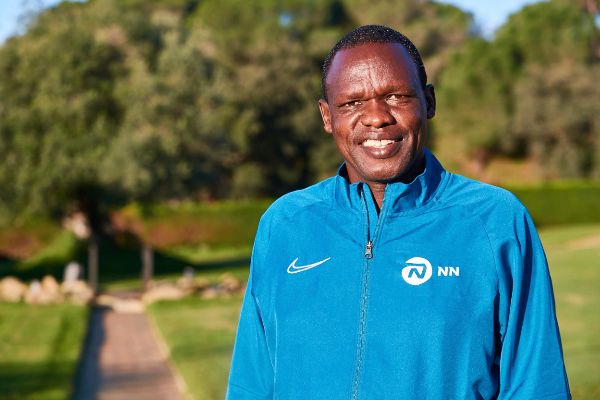- Milestone: Elli Kipchoge breaks the two-hour barrier in a custom marathon
«If I knew I would go so far? But how would I know? Let me explain: when I met him in 2000 I was still training as a coach. He went to and from Nairobi, where the International Athletics Federation taught courses. One day he appeared on the slopes. He was just a 16-year-old boy who wanted to be a runner, who was looking for help. How would I know that I would go so far? At that time I gave him the basic program I had prepared for my athletes and I paid no more attention to him. But later he was selected for the Kenya national team of the Cross World Cup and came back for more information. And then I asked him: What's your name? Eliud Kipchoge ? Okay, let's work together ».
Remember Patrick Sang (Kapsisiywa, Kenya, 1964) the moment that will define you for life.
It will never be Patrick Sang, the Olympic runner-up of the 3,000 meter obstacles at the 1992 Barcelona Games; it will be forever Patrick Sang, the master of the best marathoner in history, the one who broke the two-hour barrier this 2019. And as he says, "delighted" with the change. At the Mas Tapioles Hotel in Santa Cristina d'Aro, where he was this month as the star of the first resistance training symposium organized by the Catalan Athletics Federation, Sang smiles at each question of THE WORLD and gives a very interesting conversation.
The keys to Kipchoge's success
For example, when he talks about the reasons for Kipchoge's success: «Eliud is a very talented runner, but what distinguishes him from the rest is his ability to listen, that is his trick. Fly because he listens. In every sense. I remember that when he started, in 2002, he earned some money [he was a junior cross world champion] and gave him two tips. The first to open an account, put all your money and give it to your mother. And the second to wait a while to choose the members of his environment, his team, because then an Italian manager helped him. He listened to me without asking me the reasons and last year, when he broke the world record in Berlin, he reminded me of those tips and told me that he now understood everything, that thanks to that he could focus on running when he needed it most ».
For example, when he analyzes the objectives of his pupil next year: «Now Eliud is no longer focused on victories, on records. Your goal is to be an example. Of course, we have a calendar [will run in Berlin and at the Tokyo 2020 Games] and a plan, but the most important thing for him is to change the world a bit. That message, 'No human being has limits', is not a slogan. In many developed countries like Spain less than half of the children exercise daily. That is a very serious health problem. It is surprising that there are no more political initiatives, more solutions. Eliud wants to push people to run, to exercise, so they have a better life.
For example, when he addresses the controversy over the help provided by Nike's Vaporfly shoes: «Oh! Sneakers. First of all, let me tell you one thing: At 18, in 2003, Eliud did 12:52 in the 5,000 meters. Find out how many athletes have made a better mark than him this year [Answer: None]. That season he was world champion ahead of Hicham El Guerrouj and Kenenisa Bekele . His talent was demonstrated already then. Now, if we talk about technology, let's talk in all fields. Why do you record this interview with a latest generation phone? Why is the photographer taking pictures with a camera of the best? I am sure you could do your work with other means, but technology helps you, as in all fields. I don't understand why in athletics it generates so much debate ».
His beginnings in athletics
The talk with Sang advances to the present, but when he names a detail, that Eliud Kipchoge's mother was his teacher in the school for many years, forces him to go back.
And how did you start running? I started late, very late, in sixth grade [ESO room]. I ran for hobby, without training. At school they did a few days, by surprise I won at 3,000 meters and shortly after the teacher came to me and said: 'The director wants to meet you'. I thought: 'Oops, problems.' I went to the principal's office and there I was with a white man. I thought again: 'Oops, problems.' But no, quite the opposite. They offered me a scholarship at the University of Texas and I went there to study. Sincerely as a child I never thought of being a professional in athletics, except in winning something.But he did, well he did. Before training Kipchoge, he got three silvers in the 3,000 meters obstacles: two in the 1991 Tokyo World Championships and Stuttgart 1993 and another, the most special, in the 1992 Barcelona Games. He did it in a Kenyan triplet with Matthew Birir and William Mutwol the same day that Javier García Chico hung the bronze in pole vault. «I remember the public in ecstasy, you could tell that the country was living a very important moment in its history. The return of honor that day is one of the moments that I will remember my whole life ».
According to the criteria of The Trust Project
Know moreTraditions A 3D 'Christmas' on the facade of Cibeles and a pyrotechnics game to congratulate Christmas
Leisure The magic of Jorge Blass makes the inventions of the future come true
EnvironmentPugna between the CSIC and the Biological Station for Doñana

